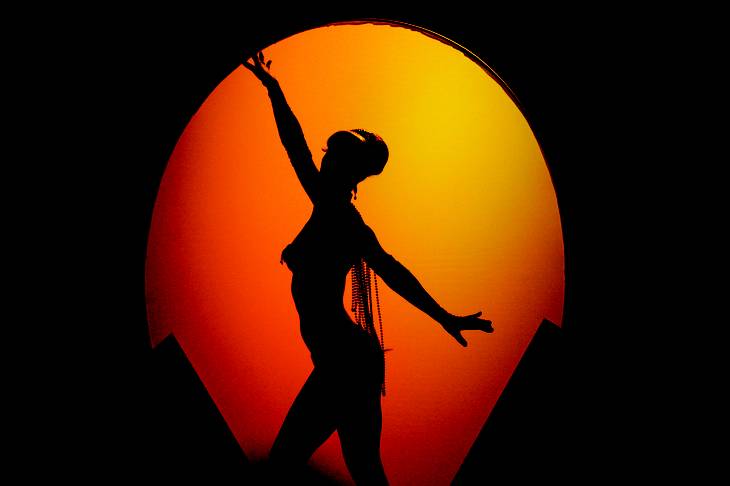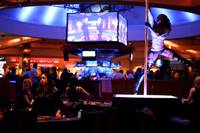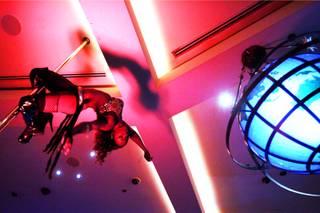STATS
- Numbers don’t lie. The adult entertainment industry is alive—and thriving—in Nevada. Strip clubs and brothels make up a viable adult industry that brings millions of dollars into the state each year. Hard to ignore, yes?
- As of 2007, there were 37 gentlemen’s clubs with nearly 100,000 registered dancers and about 2,500 dancers work on any given day. On most holidays, during big conventions and on weekends, as many as 4,000 will work.
- The average age of an exotic dancer is 23, and some are older than 50.
- Average amount attendees of AVN Adult Entertainment Expo 2009 spent on sexual entertainment, per day: Less than $150. Amount they spent on gambling: More than $500.
- The Nevada brothel industry makes from $35 million to $50 million annually.
- In recent years, brothel owners—who could be considered small business owners because they employ from 1-50 prostitutes per establishment—have purchased their brothers for between $135,000 and $5 million. These days, that’s not small change.
The imagery is everywhere.
A billboard advertising Tao Beach at the Venetian features a buxom woman and the promise, “You’ll see a lot of breast stroke. Just not in the pool.” Another of its advertisements features the backside of a thong bikini-clad woman, along with the promise that the scene is made for “sun (and moon) worshipers.” Rok Vegas, a nightclub at New York-New York, plays off the phrase “rock your ass off” with “Rok” where “rock” should be and a zoomed in photo of a woman’s derrière where the word “ass” should be. Going back to a classic, the iconic Crazy Girls ads featured the backsides of seven performers with the wordage “No ifs, ands, or...”
Individually, these ads are a little silly and perhaps all in good fun. Collectively, however, they help define a culture and reputation that, while not exclusive to Las Vegas, are found in their extreme here.
“As a city we market sin,” says Barbara Brents, a sociology professor at UNLV who has studied the sex industry in Southern Nevada. “That’s our niche market and it has propelled us into iconic status.”
But as one of Brents’ colleagues suggests, we might not have a larger sex-oriented industry than other large cities. We simply do a better job of promoting it.
Of course, the “Sin City” nickname refers to more than sex. Las Vegas has always been synonymous with gambling, though the mystique of that has waned because 48 states now offer some legal form of it. Drinking and general debauchery, such as the misadventures depicted in movies like The Hangover, are also a factor, but again, neither is mutually exclusive to Las Vegas. Just ask anyone who’s partied in Miami or New Orleans. Literal sex, then, in the form of legalized prostitution, is the only perceived sinful act still mutually exclusive to Nevada. Though Las Vegas is in a county where prostitution is illegal, in the public’s eye the two are still incontrovertibly linked. Shows like Showtime’s Gigolos, a reality television show that claims to follow the lives of five male escorts, and TruTV’s Las Vegas Jailhouse, which regularly shows women being detained for prostitution, surely don’t help.
Though they’ve never used the word “sin” or promoted excessive drinking and gambling or any form of prostitution, the Las Vegas Convention and Visitors Authority and its advertising firm cohort R&R Partners have plugged into the idea of the city as a haven for what they call “adult freedom.”
According to their research, adult freedom is what Las Vegas offers that no other destination city does. What exactly that means on an individual level, well, that depends, explains Kevin Bagger, senior director of marketing at the LVCVA. “For some people that means staying up past 9 o’clock,” he says. “For others it’s wearing those leather pants they’d never wear anywhere else.”
It was this research that led to the now-legendary ad campaign “what happens here, stays here,” which launched in 2003 and is used to market the city to American tourists. It suggests Las Vegas as the place to let your inhibitions run wild without repercussions.
This marketing of fantasy should not be mistaken for reality, but often is. Outsiders and newcomers to the city are frequently surprised at the community’s reactions to things such as non-commoditized nudity or alternative sexuality.
Consider this: In late 2009, the Erotic Heritage Museum was forced to put adhesive pasties and stickers over exposed nipples featured in a mural painted on the building’s exterior walls. It seems ironic for the community of a city whose reputation is centered on raunchiness to be morally opposed to nipples painted on the side of a building, yet, it happened. And it wasn’t the only case of its type.
Seems that “anything goes” attitude applies only to the strip of pavement known as Las Vegas Boulevard—and nowhere else.
Actually, when you compare state, county and city laws, Las Vegas isn’t a more-relaxed environment when it comes to sex-related industries such as strip clubs. One example: Adult establishments must choose between fully nude dancers or alcohol. They can’t have both, unless they’re the Palomino club, which is grandfathered into a license that allows both.
More high-end, mainstream revues such as Crazy Horse Paris at MGM Grand must also cover the genitalia of their performers.
Sally Dewhurst, marketing manager for Crazy Horse Paris, remembers a promotional event in Paris where the performers appeared topless in the production’s storefront—an occurrence you would never stumble across at a gift shop on or off the Strip.
“You know, that’s France,” she says. “A lot more seems to fly there, but, out of all the American cities, I would say that Las Vegas is pretty progressive.”
Las Vegas boasts about a dozen revues, both male and female. MGM Grand, New York-New York, Planet Hollywood, Flamingo, Stratosphere, Rio, Luxor, Excalibur, Riviera, Bally's and Hooters all have nightly revues, and other Strip properties have debuted revues that ultimately failed.
With or without full nudity, many academics argue that what these shows are selling isn’t really risqué or even real.
Brents says Las Vegas is full of “sanitized debauchery.”
Consistent and reliable data on the sex industry are difficult to find, but Brents and fellow UNLV sociology professor Kathryn Hausbeck have written extensively on the issue of the sex industry and determined that we don’t deliver the amount of sex that people might assume—we simply market it better.
“We’re making a whole lot of money off of sexuality,” Brents says. “We’re the image and the icon of sexuality, but the reality is that we aren’t that much different from other places. There are nightclubs in every other big city. We have a prostitution industry that runs illegally that isn’t as big as it is in other cities, and the brothel industry, for all its hype and symbolic importance, is really quite tiny.”
Even if Hausbeck and Brents are right about this, it may be irrelevant, because in a city where 44 percent of people’s jobs are directly or indirectly related to tourism, perception may matter more than reality.
In July, AlterNet.org placed Las Vegas third on its list of the kinkiest cities in America—behind Roselawn, IN, and New Orleans. In its explanation, it directly referred the “Sin City” label, but also cited “plentiful strip clubs, unabashed dungeon parties and bondage-themed Cirque du Soleil shows.”
In a study released in June, tourism professor Seyhmus Baloglu of UNLV’s hotel college asked tourists to think of Las Vegas as if it were a person and list three personality traits that reflect the city. “Sexy” was the fourth most common response, behind “fun,” “exciting” and “outgoing.” When asked to describe a typical visitor to Las Vegas, “sexy” appeared in third place, after “young” and “fun.” When visitors were asked to name images they associate with Las Vegas, gambling won out, which should surprise no one. Sex came in seventh, behind shows, fun, drinking, casinos and lights.
So, regardless of how prudish local laws and culture may be in reality, Las Vegas has been deemed a sexy place in the court of public opinion, and that alone creates an impact.
It very well may play be a deciding factor for 15 to 20 percent of Americans the LVCVA acknowledges would never even consider coming to Las Vegas. Not much is known about this demographic, as the LVCVA understandably chooses to focus on the 80 to 85 percent of potential travelers who would consider the trip, but it very well could be on moral grounds.
Perhaps more easily quantified is the effect our sexed-up reputation has on locals, especially vulnerable populations such as teenagers.
UNLV psychology professor Cortney Warren studied body image issues of Hispanic teenagers living in Las Vegas. As a part of this, she went to Valley High School to conduct an eating disorder prevention and media literacy intervention program, which teaches individuals to question the unrealistic images of beauty portrayed in mainstream media and advertising.
She found that male and female teens had negative opinions of their own bodies. While this isn’t exactly uncommon among teenagers, Warren thinks the issue is far more pressing in Las Vegas, where unrealistic body images are reinforced everywhere—on cabs, in billboards and by scantily clad casino employees.
Yet perhaps more worrisome, Warren says many ninth-grade girls she interacted with expressed a desire to become exotic dancers.
“I was mortified by this,” Warren says. “I was blown away. In most cities in the world you wouldn’t come across so many girls saying they want to be strippers. It’s seen as dirty from a cultural perspective. It’s not glamorized. Here, strippers represent something positive—the ability to make a ton of money. It’s a desirable opportunity.”
The Valley freshmen Warren interacted with may be extreme examples, but the sentiment that growing up in Las Vegas instills a thicker skin when it comes to sexy and raunchy images is something many locals agree with. Sometimes, the images may be so prevalent that locals don’t realize how accustomed they are to them until they are gone.
At least this is exactly what I experienced when I ran off to the Florida Panhandle at the ripe old age of 18. I’d spent the majority of my formative years in Las Vegas. The white-sand beaches and 60 varieties of sweet tea did their best to welcome me, and, sure, they were nice, but the only time it ever felt like home was when I stood on a pier in Destin and saw a Girls Gone Wild bus drive by. It was Spring Break—and I smiled.
That Las Vegas affects its locals, especially its youth, isn’t shocking. Every city does, in one way or another.
So, again, the question is: In what way does all this matter? Do businesses give any thought to the sociocultural climate of their host cities or are they solely driven by the almighty dollar?
Somer Hollingsworth, CEO of the Nevada Development Authority, concedes that Las Vegas’ reputation does affect their attempts to lure companies here, but only because it overshadows the state’s business-friendly climate. That’s unlikely to change, given that NDA operates on a budget of $2.2 million annually—chump change compared to the funding behind the LVCVA,
whose summer marketing campaign alone was $24 million.
“People don’t know the business climate here,” Hollingsworth concedes, “but I think that we could change the minds of any company with preconceived notions by showing them Nevada is a compelling place.”
That they face an uphill battle is a necessary evil. Hollingsworth doesn’t think anyone should criticize the way Las Vegas has marketed itself. Those campaigns and that branding worked, he points out, and the resulting revenue creates the business-friendly climate that nongaming companies will find attractive. The relationship, then, is symbiotic.
“It’s like the goose that laid the golden egg,” he says. “You don’t kill that. They’re No. 1 and in the meantime, we’ll diversify.”
Hollingsworth chooses to focus on the positive. Others have been more critical. Plenty of politicians, analysts and academics have offered their own theories as to what might be hindering the business of attracting businesses to Southern Nevada.
In February, Sen. Harry Reid told the Nevada Legislature, “If we want to attract business to Nevada that puts people back to work, the time has come for us to outlaw prostitution.” The theory here is that upstanding businessmen and women don’t want their children growing up with brothels in their backyards.
Similarly, many, including former Sen. John Ensign, have suggested that our underperforming K-12 education system is what drives businesses away. The theory is the same: People don’t want to transfer their children to such a low-ranked educational system.
Some point to a struggling higher-education system failing to create an educated workforce as the primary speed bump in an out-of-state business’ road to Southern Nevada. Others believe the bottom line is financial incentives given by the state. If Nevada’s were alluring enough, nothing else would matter.
Anecdotal evidence exists to support each of these theories. In December, developer Rich Worthington of the Molasky Group of Cos. said furniture giant Ikea and Internet service provider EarthLink considered moving parts of their businesses to Nevada but didn’t because of the region’s lack of college graduates.
Recruiters for companies based in Southern Nevada also face uphill battles when bringing potential employees here. Christa Foley, the recruiting manager for Zappos, says her company has difficulties recruiting software engineers and higher-level positions such as managers, especially when the potential employees have children. She attributes it to the city’s adult reputation and troubled school system.
In August 2007, the Lied Institute of Real Estate Studies brought together 40 prominent members of local government, business, academia and the real estate industry to discuss economic diversification. They flagged several things as hindrances to corporate recruitment in Las Vegas, including the “Sin City” persona, lack of affordable housing, poorly educated workforce, weak school system and a lack of cultural amenities.
To look at perceptions from a different point of view, companies based in Los Angeles should have fewer cultural reservations about Las Vegas. Moving away from Hollywood and the porn production capital of the world into Las Vegas, sin or no sin, shouldn’t take too much of a mental mind shift.
According to Brown, one LA-based industry is showing signs of growth in Las Vegas: Cosmetic procedures. “People are starting to come here to have them done,” he explains. “It isn’t a lot yet but there’s some, and that’s something that Las Vegas could be known for in the future.”
And with that, we’re back to boobs.


